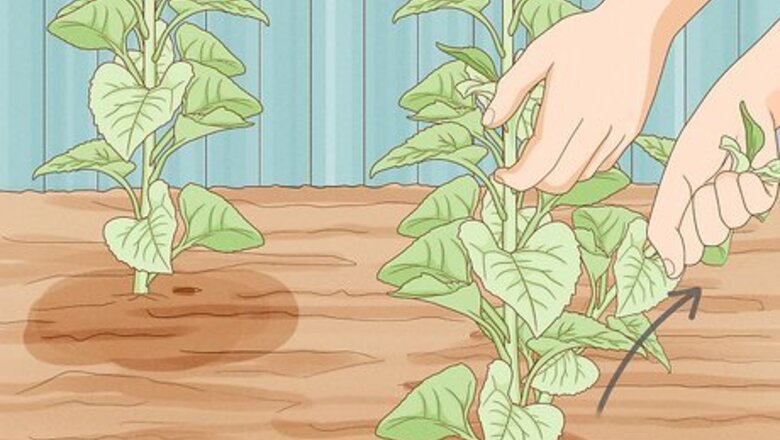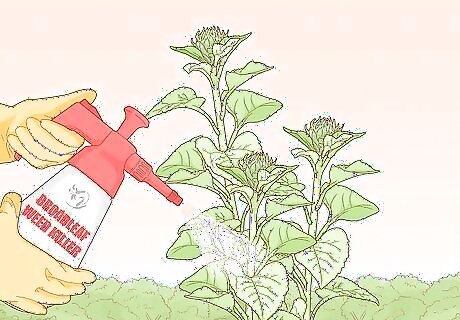
views
Getting Rid of Existing Sunflowers

Pull up sunflowers from your garden. You can get rid of sunflowers by pulling them up from the soil with your hands. Try to do this before the seeds develop. If the seeds develop, removing the plants becomes harder because the seeds could get dislodged and scatter around your garden. Any seeds that scatter may regrow the following year. If you have to remove mature sunflowers with seed heads, put some sheeting down—like an old dust sheet or tarpaulin—underneath the plants. This will catch any seeds that fall. Shake the cloth into the compost can once you’re finished.

Remove sunflowers using chemicals. Sunflowers are broad-leaved plants so a broadleaf weed killer should get rid of them. Check the manufacturer’s instructions before using the weed killer. In most cases, the approach will be to carefully apply the weedkiller to the leaves of the plant you wish to remove. Take care not to get any on nearby plants you wish to keep. Chemical controls will only work on growing plants. Any dead, woody plants will need to be cut back and dug up.

Keep the sunflowers from getting sunlight. One intense approach to getting rid of any unwanted plant is to keep it from receiving any sunlight. To do this: Pin a light-excluding material, such as weed barrier sheet, also known as landscaping fabric, over the area affected. Some gardeners have success by laying several sheets of newspaper on the ground and pinning it down with a heavy mulch such as well-rotted manure or bark chips. By the time the newspaper rots away the seeds below will no longer be able to grow. Whatever you use, take care to choose a material that permits water to penetrate. You’ll need to keep the cover on the ground for roughly six months to a year.

Cut down sunflower stalks. Once sunflower blooms fade, a tough stalk remains in the ground. These aren’t easy to remove but it can be done. Cut the sunflower down to knee height using a small saw or pruning shears to cut through the woody stem. Grab the remaining stalk and pull it out of the ground. If it’s really hard, try hacking away at the roots a bit with a mattock or trowel. This will help loosen the plant’s grip on the earth. Remember to use gardening gloves.

Remove sunflower root balls from the soil. Once dislodged, sunflower root balls should be removed from the soil as much as possible, as it will be hard to plant around the tough roots. The woody root and stalk won’t compost very quickly, so consider burning them instead. However, use extreme caution when doing this.
Preventing Sunflowers from Regrowing

Remove sunflower seedlings by hand. Provided you can recognize what a sunflower seedling looks like, you can remove sprouting sunflowers by hand removal or by hoeing. Hoeing works well on a dry day as any seedlings you uproot will dry out and die before they can re-root. A sunflower seedling has a small stem and two green, oval shaped leaves at the very top of the stem. In a week, it will have four leaves, all pointing out from the center of the stem, almost like the top of a helicopter.

Do not try to burn away seedlings. It isn’t recommended to try burning away seedlings as this is a dangerous method of removal but some gardeners risk it anyway. This is especially unwise in dry conditions or near any flammable materials, such as a wooden fence.

Dig up perennial sunflower roots. Perennial sunflowers naturally regrow year after year from the same plant. These have deeper roots than annual sunflowers and the roots have tubers and rhizomes attached. You’ll see perennial sunflowers emerge in the early spring, which is a bit sooner than annuals. Perennial sunflowers spread via their roots as well as via seed, so you need to dig the roots up to be rid of the plant completely. It’s best to burn the root mass or put it out with the trash rather than compost it as it may regrow.

Prevent annual sunflowers from self-seeding. Annual sunflowers will self-seed (scatter their seeds which will regrow the following year) if left to do so. Birds will also help scatter the seeds by feeding from the seed head. It’s best to cut back the flowers immediately after the blooms are past their prime. If the plant still has other flower heads that are coming out, try to remove old blooms by cutting off the spent flower heads where they join the plant. This allows you to enjoy the other flowers as they emerge.

Remove annual sunflowers when they are done flowering. Once all the flowers are spent, cut the stalk of the annual to about knee height. This allows you to pull the remaining stalk out of the ground. If you aren’t bothered about leaving a woody root mass in the ground and don’t intend to pull it, you should cut it off as close to the ground as possible.

Restore your soil after removing the sunflowers. Sunflowers are ‘hungry’ plants that will absorb a lot of nutrients from the soil. Other plants that you put in the same spot may miss out on nutrition if you do not restore the soil. Use an improver such as compost or well-rotted manure before you replant the area. Do this immediately after removing the sunflowers. Try to do this in the fall before the ground gets too cold.




















Comments
0 comment